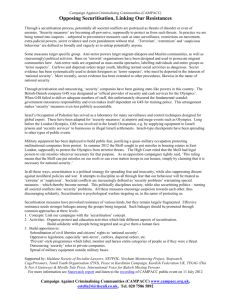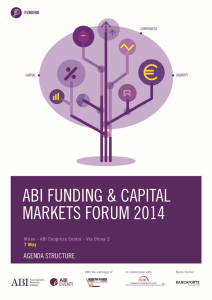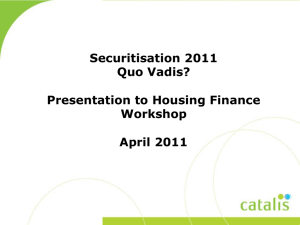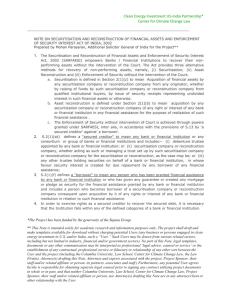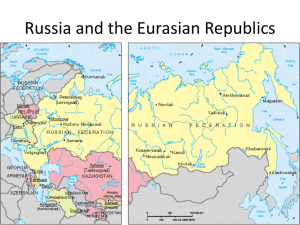Securitisation in Russia and CIS
advertisement
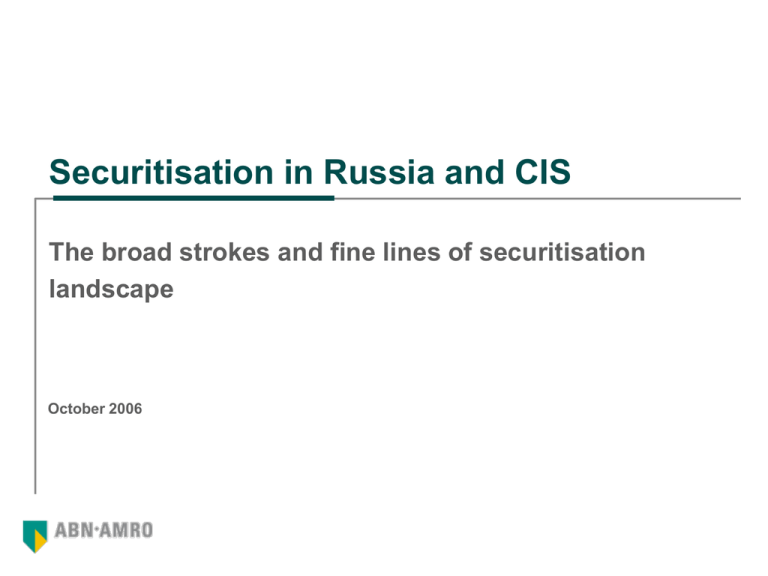
Securitisation in Russia and CIS The broad strokes and fine lines of securitisation landscape October 2006 Table of Contents 1 CIS Market Update 3 2 Future development of securitisation in Russia and Kazakhstan 8 3 Kazakhstan case study 16 4 Panel discussion 26 2 1 CIS Market Update Market Economics: Glam or Glum? Outlook FITCH MOODY’S S&P RUSSIA BBB+ STABLE Baa2 STABLE BBB+ STABLE KAZAKHSTAN BBB STABLE Baa2 STABLE BBB- POSITIVE Russian CDS spreads are at historic lows Economic indicators RUS 80 KZT GDP growth 7.40% 9.40% – 40 Unemployment 5.40ml – 0.11ml 20 Current Account 27.01bl 0.35bl Trade Balance 12.05bl 4.10bl CPI 9.60% 8.50% Kazakhstan Sep-06 Jul-06 May-06 Mar-06 Jan-06 Nov-05 Sep-05 Jul-05 May-05 Mar-05 0 Jan-05 60 Nov-04 CDS spread 100 Russia 4 Market Economics: Glam or Glum? Demand for consumer goods/services is growing in line with rising consumer confidence Growing asset base for potential securitisation. In 2005 loans to households in Russia doubled Banking sector profitability remains strong Some concerns over relaxed lending standards to mortgages Gap between Russian banking sector rating (BB) and the credit quality of their assets creates potential for further securitisation. Very similar situation in Kazakhstan Market innovation to grow as market has seen its first publicly-placed consumer-loan ABS transactions 5 Market developments in EEMEA region EEMEA ABS issuance volume by country 2001 – 2006* 2.6% 1.5% EEMEA ABS issuance 2001 – 2006* 9 2.6% 12.2% 8 7 7.8% 6 0.2% (EUR Bil.) 38.2% 1.4% 33.4% 0.1% 4 Future Flows Existing Assets 3 2 Poland Russia Egypt Rep. of Latvia South Africa Tunisia UAE Turkey Czech Rep. Kazakhstan 5 1 0 2001 2002 2003 2004 2005 2006* ABS volumes are dominated by Turkey and South Africa and followed by Russia In 2006 ABS issuance in EEMEA region approached €4.1bil in the first 7 months compared to € 181.1bil generated in European market Issuance evolves naturally from future flows to existing assets in positive credit cycle Source: S&P, * to end July 6 Market developments in EEMEA region EEMEA ABS issuance volume by asset type 2001 – 2006* 1.4 1% Aircraft CMBS Credit card Future flows Other Small business loans Auto loans Consumer loans Equipment Leases RMBS 0 Auto loans Future flows CMBS Leases Consumer loans RMBS Turkey 56% 0.2 Tunisia 1% 0.4 South Africa 7% 0.6 Russia 2% 0.8 Poland 2% 1 Kazakhstan 10% 1.2 Czech Republic 2% 2% (EUR Bil.) 2% 15% 2006* EEMEA ABS issuance Credit cards Small business loans Residential mortgages (RMBS) expected to grow. Almost 80% of European market The first Russian true sale ABS transactions completed in 2005 and currently actively driven by leases, consumer loans, future flows and RMBS Kazakhstan has seen its first true sale securitisation of residential mortgages in February 2006 In selected cases, future flow remains cost effective Source: S&P, * to end July 7 Recent CIS Transactions Originator Asset Class Amount ml Country Senior tranche rating Senior tranche pricing Sep-03 Halyk Future Flows $100 Kazakhst an Baa2 Private Nov-04 Rosbank Future Flows $225 Russia Ba3/B+ 9.75 (fixed) Jul-04 Gazprom Future Flows $1250 Russia -/BBB-/BBB- UST4.875 2012 +299 Dec-04 The Baltic American Enterprise Fund* Existing Assets $64.9 Latvia Aa2 LIBOR+75 Jul-05 Bank Souyz Existing Assets $62 Russia Baa3 3m LOBOR+175 Dec-05 Home Credit & Finance Bank Existing Assets € 126.5 Russia Baa2 EURIBOR +250 Nov-05 JSC Russian Standard Bank Existing Assets € 300 Russia Baa2/-/ BBB EURIBOR + 165 Mar-06 Alfa Bank Future Flows $350 Russia Baa3 LIBOR+160 Apr-06 Russian Railways Existing Assets RUR 12,570 Russia Baa2 8-3/8% cpn, priced at 101.252 Feb-06 BTA Ipoteka Existing Assets $150 Kazakhst an - Private Feb-06 KKB Future Flows $200 Kazakhst an Aaa/AAA/Baa1/ BBB 1m LIBOR +24 Jul-06 Vneshtorgbank (VTB) Existing Assets $88.3 Russia A1/BBB+/- 1m LIBOR+100 Aug-06 Russian Interregional Bank for Existing $72.5 Russia Development Assets *Has been included for comparison reasons Baa2 3m LIBOR+160bps 8 Market Developments in CIS Rapid expansion in consumer asset pool Legal, tax and regulatory environment is better understood ABS transactions are becoming an increasingly popular tool of funding in CIS and Kazakhstan Diversified funding source and improve cost of lending Rating agencies are becoming more familiar with the legal framework, macroeconomic situation, and the underlying assets to be securitised 9 2 Future development of securitisation in Russia and Kazakhstan Main Securitisation Drivers Balance Sheet Management Regulatory Capital Relief Match Funding to Asset Reduce Gearing Release Loss Reserves Strategic Economics Create Publicity Lower Financing Cost Capital Markets Presence Extension of Tenor Less Corporate Covenants Diversified Funding Source Less Price Volatility No Dilution of Corporate Funding 11 Challenges for Market Expansion Major Challenges for Originators Establishment of clear underwriting standards and collection procedures Build up of loan portfolios with consistency … and credit quality Proven track record for specific loan types Set-up IT systems to accommodate securitisation requirements Major Market Challenges Development or refinement of the legal framework to facilitate true sale securitisations: – Achieving an insolvency remote transfer of assets/loans – Proper protection of creditors and investors; – Efficient transfer of underlying securities (e.g. residential mortgage loans) Clarification or ascertaining of tax positions – Withholding taxes; – VAT – Stamp duties Regulatory treatment for the portfolio sale Development of a local SPV infrastructure and issuance of ABS notes in local currencies 12 What does the future bring for CIS …? Future Flow to continue, especially for – Countries where sovereign is below investment grade – New capital market entrants – To extend funding tenor True Sale ABS structure for Existing Asset to dominate New asset classes Improved understanding of market standards yielding better rating outcomes and wider investor demand Despite challenges remaining for RMBS the demand for funding will lead to steep growth Local ABS subject to development of local investor community Greater focus on regulatory capital treatment 13 The Crème de la Crème of Asset Classes in CIS Consumer assets will continue to grow Short-term consumer assets that do not require security are easiest from a legal perspective In addition these assets often have short tenors and high excess spread Specifically, consumer loans and auto loans have been and will continue to be positive Residential mortgages will become increasingly popular and have the highest potential In 2006 approximately 80% of European consumer ABS is RMBS Challenges remain for RMBS – Lack of efficient long-term FX swap market – Questions regarding the ability of a foreign SPV enforcing security in an economic stress scenario – Rapid appreciation of real estate prices in the CIS – Relatively small amount of excess spread available to cover losses (4-9% vs. 20-30% for consumer assets) Despite these challenges the demand for funding will lead to steep growth in RMBS from the CIS 14 Funded vs. Synthetic Securitisation To date all transactions in the CIS have been funded transactions Funded transactions Can provide both funding and regulatory capital relief – Will remain the choice for all but the highest rated issuers as asset securitisation will continue to provide competitively priced funding – Can provide ALM management by matching tenor of funding to tenor of assets Synthetic transactions May be a good option for the highest rated issuers who would like regulatory capital relief but have competitive funding alternatives (i.e. Eurobonds, syndicated loans, local bonds, funding from parent) – Challenges remain for Synthetic securitisation – Lack of super senior Credit Default Swap provider – Lack of clarity on the views of the regulator and accountants 15 The Alchemy of Securitisation: Capital Relief According to Russian statutory rules capital relief is based on a “legal approach” Sale of assets provides de-consolidation of assets and off-balance sheet treatment of these assets Russian Regulatory Capital rules: – Minimum ratio of total capital adequacy N1=10% – Risk weighting is 100% for corporate loans, auto loans, retail loans – For securitisation no specific accounting or capital adequacy rules 16 The Alchemy of Securitisation: Capital Relief Scenario 1 Scenario 2 Portfolio of consumer loans of USD 100mln Portfolio of consumer loans of USD 100mln • Risk weighted assets USD 100mln • Minimum ratio of Total Capital adequacy N1 = 10% • Risk Weighting Assets (RWA) = USD 100mln Capital required = USD 10mln • Portfolio is sold to off-shore SPV • True sale (no recourse) • Credit enhancement = USD 10mln of subordinated loan • After securitisation RWA of consumer loans = 0% • Subordinated loan will result in RWA of USD 10mln consuming the capital of USD 1mln Capital required = USD 1mln 17 Unveiling Accounting Considerations The accounting rules in Russia are changing towards IFRS. Basel II will be partly implemented in Russia in 2008-2009 (Minimum Capital Requirements, Pillar 1) Contrary to the CBR statutory rules, IFRS uses a “risk transfer approach” for the de-recognising of assets The following key questions should be considered: – Does the Originator have to consolidate the SPV? – Can the Originator / Seller de-recognise the assets on sale to the SPV? For de-recognition of assets the two main criteria should be checked: – Control – Risks and Rewards These rules are introduced by the revised IAS 39 which implements more stringent rules on consolidation of SPV and new tests for de-recognition 18 3 Case Study First Kazakhstan RMBS Transaction First one in Kazakhstan … 20 Securitisation Funding Solution As is the case with many Originators in the CIS, BTAI had a relatively small but quickly growing mortgage portfolio As BTAI’s portfolio was not of sufficient volume to justify a Term Securitisation, ABN AMRO structured a Warehouse to allow room for further origination Warehouse funding can be refinanced at any time with no penalty After a Term Securitisation is closed, the Warehouse will remain in place to fund the BTAI’s ongoing loan origination EUR mln Example for Warehouse funding 140,0 120,0 100,0 80,0 60,0 40,0 20,0 0 Term Securitisation 0 3 6 9 12 15 18 21 Months from close of Warehouse financing 24 21 Warehouse Structure Overview The loans were sold to First Kazakh Securitisation Company B.V., a newly established special purpose vehicle (SPV) located in the Netherlands The SPV is ultimately funded by an ABN AMRO-sponsored multi-seller conduit (rated A1+ / P1 by S&P and Moody’s, respectively) The transaction is partially enhanced by political risk insurance provided by Multilateral Investment Guarantee Agency, a subsidiary of the World Bank Custodian (Bank CenterCredit) Back-up Servicer (Halyk bank) Security Trustee Calculation and Paying Agent Originator / Seller / Servicer (BTA Ipoteka) [Notification of Sale] Borrowers Mortgage Certificates True Sale (KZ Law) First Kazakh Securitisation Company BV Warehouse facility ABN AMRO Bank Conduit CP ABCP Investors Sub-Loan [Loss-payee assignment] Political Risk Insurer (MIGA) Interest Rate Swaps Liquidity Facility, Letter of Credit, FX Hedging 22 Structural Enhancements & Transaction Benefits The combination of “structural enhancements” allowed the company to raise funding at a very attractive cost Benefits of the transaction Cost efficiency – Allowed to raise financing at the level significantly cheaper than BTAI’s previous funding Independency from parental funding – The transaction allowed to diversify BTAI funding sources and to achieve less dependency on Bank TuranAlem Increase of the funding amount – Able to raise an amount of funding 5 times bigger that the largest international finance of BTAI to date “Stepping stone” transaction for entering the term ABS markets – Generating more data history – Practice operational procedures Transaction structural enhancements All collection proceeds to be daily transferred into secured offshore bank account Security over collection accounts Subordinated loan provided by the Originator Trustee to monitor accounts – Accelerated cash flow “waterfall” to apply following an event of default – Trustee can take control of accounts in specified circumstances following an event of default Back-up Servicer appointment from the start Parent servicing performance guarantee Certain portfolio performance triggers in place Underlying portfolio linked to foreign currency – daily conversions Mortgage Certificates held by Custodian Contingent hedging arrangement Political Risk Insurance will cover risks of convertibility and transferability of collections and expropriation of the collateral 23 Execution – Major Challenges of the Transaction DOCUMENTATION / LEGAL DUE DILIGENCE STAGE RATING PROCESS True Sale Structure Legal environment (foreclosure and court procedures) Claw back from Originator Commingling Risk Fiscal Implications Regulatory approvals New jurisdiction SECURITISATION TRANSACTION Time consuming Internal procedures Systems adjustments Changes in day to day operations Accounting Lack of historical data Unfamiliarity with concept and documentation DUE DILIGENCE STAGE Extensive due diligence phase Rating agencies had to set up rating methodology for Kazakhstan Extensive transaction documentation 24 Lessons from Kazakhstan and other EMs In Kazakhstan the following points were confirmed: – Local and international presence for third parties is key (bank, tax and legal) – While Mortgage Certificates can offer a clean legal sale, operationally the sale can be very difficult (endorsements, custodian, etc) – In the absence of historical data, limited information or even examples can give the Rating Agencies comfort – The due diligence phase is more extensive than Originators anticipate – The feasibility study will never resolve all issues – choose an arranger you trust to solve structural challenges Lessons we have learned in other Emerging Markets jurisdictions: – European investors prefer “simpler” structures – If there is no data the Rating Agencies will take very conservative views – Ultimate rating levels are not entirely independent from the Originator’s or country’s rating – Investors can be unpredictable, involve the sales force early in structuring phase 25 Execution Challenges for Originator Extensive transaction documentation in English In depth due diligence by the Rating Agencies and the arranging bank – Historical asset performance – Underwriting criteria – Servicing standards – Experience with delinquency and foreclosure Adjustments in internal systems and procedures – IT systems – Accounting procedures and internal instructions – Reporting requirements for securitisation Efficient and timely registration of Mortgages Certificates in the regions 26 Axioms for a successful transaction Use accomplished arranger and other third parties Establish generic funding program Permits repeat low cost issuance Target highest ratings to obtain widest distribution and tightest pricing Securitise core assets SUCCESSFUL TRANSACTION Establish a dedicated deal team Develop funding program around existing practices Customer franchise unaffected Less operational risk – straightforward execution Main parties to the transaction need to have local knowledge and presence as well as international experience with structured finance Modification of offshore structures and precedent Firsthand experience and solutions for challenging issues Ability and authorisation to make decisions 27 Meet ABN AMRO Team Gary Watmore, Executive Director, Global Head of Developing Markets Asset Securitisation Tel: +44 20 7678 6288, Fax: +44 20 7678 3597, E-mail: gary.watmore@uk.abnamro.com Tim Vieth, Director, CEEMEA Asset Securitisation Tel: +44 (0) 20 7678 1949, Fax: +44 (0) 20 7678 3730, E-mail: tim.vieth@uk.abnamro.com Dan Stadnik, Director, CEEMEA Asset Securitisation Tel: +44 20 7678 5827, Fax: +44 20 7678 3597, E-mail: dan.stadnik@uk.abnamro.com Maria Bazhanova, Associate, CEEMEA Asset Securitisation Tel: +44 (0) 20 7678 4872, Fax: +44 (0) 20 7678 3730, E-mail: maria.bazhanova@uk.abnamro.com Alex Ivanov, Associate, CEEMEA Asset Securitisation Tel: +44 (0) 20 7678 2980, Fax: +44 (0) 20 7678 3730, E-mail: alex.ivanov@uk.abnamro.com Natalia Joubrina, Associate, CEEMEA Asset Securitisation Tel: +44 (0) 20 7678 6819, Fax: +44 (0) 20 7678 3730, E-mail: natalia.joubrina@uk.abnamro.com 28 4 Panel discussion Making more possible 30
